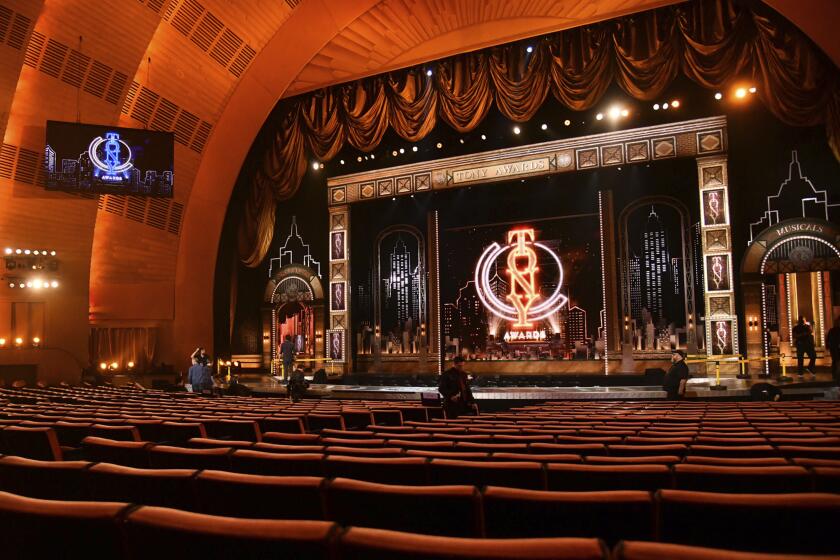ART REVIEW : Show Projects Perceptions of World in Varied Ethnic Filters
- Share via
There are as many Asian experiences of America as there are Asian-Americans, and the negative side of lumping together members of several distinct ethnic groups in a “ghettoized” art exhibit hardly needs underlining here. Yet a small exhibit at Rancho Santiago College in Santa Ana offers a plausible reason for juxtaposing work by artists of Chinese, Japanese, Korean, Laotian and Vietnamese heritage.
“Junctures, Disjunctures & Fusions: Asian American Artists” is about different ways artists have responded to culture shock--living outwardly “American” lives but perceiving the world through the filters of vastly different kinds of cultural conditioning.
Wisely refusing to draw any pat conclusions, guest curators Carol Miura McCormack and Shifra M. Goldman allow the disparities among the artists’ works to stand on their own. It is true, however, that the viewer’s reaction to the work is inevitably heavily conditioned by reading about the artists’ lives in the accompanying catalogue. An outsider thereby gains a level of emotional involvement that in some cases ultimately may have more to do with the personal histories than with the works of art.
Judy Chan’s bound figures are the most poignant testimonies to a life of “disjunctures.” They are dummylike creatures made of black-painted cord, tar paper, raffia, plastic and wires with coarsely dangling plug ends, suggesting an overwhelming feeling of bitterness and impotent rage. The derelict shabbiness of Chan’s figures broadcasts a message of abnegation and self-loathing. A tiny length of wound red string or gold cord serves as the sole sign of hope.
The catalogue explains that Chan, the second girl born (in 1939) to second-generation Japanese-American parents, was an enormous disappointment to her military-caste family, anxious to pass down their fine name to a boy. Her mother’s response was to subject Chan to “years of verbal abuse, neglect and punishment in a dark cellar.” Later, submitting passively to insensitive guidance at her American high school, she toiled miserably in an office.
In a series of prints, Chan relives the childhood horror of the cellar. Repeated images of descending steps and a cookie-cutout little girl’s silhouette create an aura of obsession, loneliness and terror.
Hahn Thi Pham displays a moody theatricality in the several versions of her “Post Obit Series,” groupings of large-format photographs that deal in mystical terms with what she calls the “life-in-death” years since she left her comfortable home in Vietnam in 1975.
Posing herself and other women within spare, carefully spotlighted settings, she conjures up otherworldly imagery of her own dead-white “soul,” mysterious nude blue women with long flags of hair, gossamer swags of cloth moving in a slight breeze, solemnly dancing robed figures, potted banana palms and half-peeled bananas (symbolizing her homeland) lying in careful patterns on the floor.
Although the precise meanings of these scenes are not always clear, and a few images (like that of a tightrope) seem too flatly obvious, the accumulated impact of repetition, vivid costuming and precise, stylized poses leaves a strong imprint of troubled dreams and unresolved conflicts. Even her American husband turns away in one photograph, unable to understand.
Three other artists represented in the exhibition play it closer to the vest.
American-born Mary Noguchi makes large wall pieces in kimono formats with cotton fiber dipped in non-fired clay slip. These stiff, rough-surfaced gray objects incorporate barely readable images of faces and landscapes and handwritten rows of names (the surnames of Noguchi’s grandmothers). On the floor below are boxes containing ashes.
The aura of death and blurred remembrance hangs about these unwearable ghosts of garments. Their grimness evokes the bitterness of Noguchi’s family’s banishment to Japanese internment camps during the war. The indistinct, self-effacing quality of these pieces suggests an echo of the family’s ardent desire to blend quietly into American culture.
Samuel Suhr is a young Korean who suffered more than the usual adolescent pangs of alienation and insecurity. When his family immigrated to a town in Virginia, he was the butt of ridicule. His work is a curious kind of escapism, dwelling in loving detail on the meticulously detailed treatment of bizarre, hyper-realistic scenes painted on boxlike “shrines.” Close-up, the vaguely religious and mythological paintings turn out to be infested with worms or peculiar little scenes of human body parts.
Mary Sun’s work is the most public and impersonal in the group, although it has a source in the Shanghai-born artist’s personal background: Her family was split between supporters of Sun Yat-sen and members of the Chinese revolutionary government.
Intrigued by the variety of political expression in Los Angeles’ Chinatown, Sun photographs cheerfully dogmatic Chinese Communist posters and cheerfully dogmatic Chinese Nationalist posters. Photocopied and sharpened with brilliant added color, the posters seem more like decorative bits of litter than conveyances of meaningful messages.
The exhibit is the rare kind of show that subverts a gallery-goer’s casual browsing and says, in playwright Arthur Miller’s famous phrase, “Attention must be paid.” Although all the work is not equally strong, the intense personal element so vibrantly in evidence is a welcome reminder that not all art made today is ironic and aloof.
“Junctures, Disjunctures & Fusions: Asian American Artists” remains on view through Nov. 22 at Rancho Santiago College Art Gallery, in Building C on the campus, at the corner of Bristol and 17th streets in Santa Ana. Gallery hours are Monday through Thursday, 10 a.m. to 2 p.m.; Friday, 11 a.m. to 1 p.m., and Tuesday and Wednesday, 6:30 to 8:30 p.m. Admission is free. Information: (714) 667-3177.
More to Read
The biggest entertainment stories
Get our big stories about Hollywood, film, television, music, arts, culture and more right in your inbox as soon as they publish.
You may occasionally receive promotional content from the Los Angeles Times.










